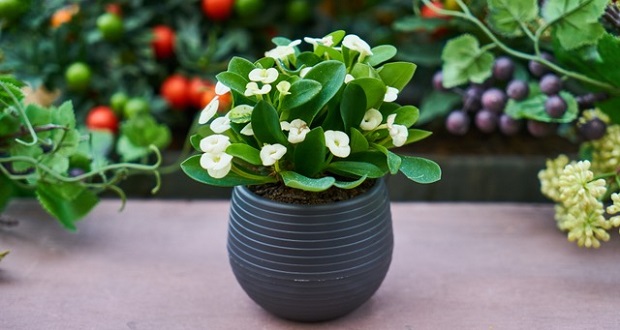By Brian David —
How are you at growing plants in containers? From Dixie cups to fifty gallon barrels, the size of a container and its material composition make container gardening different from nurturing plants in the earth. Clay pots are porous, for instance, and plastic pots are impermeable. A plant’s nutrients, air flow and water need special attention in any type or size of container.
Container gardening allows for a broad spectrum of plant life, and container mobility enables a grower to change plant environments, indoors and out. Container plants range from Tillandsias, or air plants (no soil needed, just air and moisture), to Nymphaeas or water lilies (aquatic sub-mersed plants).
In Merced, U.C. Master Gardeners gave the Happy, Healthy Container Gardens presentation last month. Evidence-based procedures and processes were backed by container gardening experience specific to Merced County.
Pat Shay demonstrated container planting arrangements, with presentation notes and links available here. Any container needs a minimum of one drainage hole covered with a piece of fine wire or nylon cloth. Without proper drainage water usually pools, drowning the plant’s roots. Over-watering is the primary cause of death for container plants.
To determine your soil’s moisture place your finger in the soil up to your knuckle. If the soil is sticking to your finger your water content is usually sufficient. If there is sparse dry soil hardly clinging below your knuckle you should water your plant. A more technical way to test your container plant’s water needs is to use a moisture meter.
The smaller and more porous a container is, the more water your plant will need. Hot or windy conditions warrant checking moisture content daily. Two ways to protect your plants from dehydrating through California’s long, hot, dry season include insulating your container by double potting and keeping containers off hot, reflective surfaces.
Potted plants have limited nutrients available so they need amendments supplied every 60 to 180 days. Most potting soil mixes provide a few months’ worth of nutrients. Master Gardener Nicolai Laquaglia emphasized that container soil can not regenerate so it needs regular feeding and occasional changing. “You want a porous, sterile potting soil that allows water and air to reach the roots of the plants.”
To make your own potting soil, mix in an aggregate like vermiculite (expanded mica/ fools gold), perlite (popped lava pebbles), or crushed lava rock with a sphagnum moss, peat moss or coir (shredded coconut shell) amended with compost. Then add in supplement feeding with a fertilizer like worm castings.
Brian David is a U.C. Master Gardener, Mariposa
Visit our UCMG website
Follow us on Facebook
Listen to local interviews on KRYZ 98.5 FM
The U.C. Master Gardener Helpline and Helpdesk are staffed Thursdays from 2 – 5 p.m. Please contact the helpline, or leave a message by phone at: (209) 966-7078. By email (send photos and questions for researched answers) to: mgmariposa@ucdavis.edu
Master Gardener Office Location:
UC Cooperative Extension Office, 5009 Fairgrounds Road, Mariposa, CA 95338
Phone: (209) 966-2417
Email: mgmariposa@ucdavis.edu
Website: http://cemariposa.ucanr.edu/Master Gardener/



